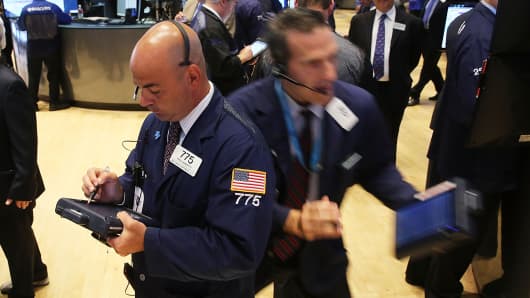Jeb Bush kicked off his campaign in June on a positive, aspirational, pro-growth note, saying, “There is not a reason in the world why we cannot grow at a rate of 4 percent a year.” That thought has some substantial history behind it.
Most immediately, it goes back to a board meeting of the George W. Bush Institute in 2010, at which executive director James Glassman raised for discussion the subject of a pro-growth economics agenda. Board member Jeb Bush proposed the 4% goal then.
Glassman had the good sense to turn that discussion into a full-length book, in a project spearheaded by the gifted Amity Shlaes (who is also one of the contributors to the volume).The 4% Solution: Unleashing the Economic Growth America Needs was published in 2012 by Random House. It comprises 21 chapters written by 26 authors, including Economics Nobel Prize winners Robert Lucas, Vernon Smith, Edward Prescott, Gary Becker, and Myron Scholes, as well as serious economists such as Robert Litan, Kevin Hassett, David Malpass, Eric Hanushek, Pia Orrenius, Peter Klein, W. Michael Cox, Steven Gjerstad, Maria Minniti, Nick Schulz, and Madeline Zavodny.
But the unread chairman of President Obama’s Council of Economic Advisors, Jason

Furman, snarled in response to Bush’s 4% growth target on CNBC on August 7, “I haven’t seen any serious economist say that is within the realm of possibility.” The 4% growth target is a sensitive subject for the chairman of Obama’s CEA. Growth under President Obama has averaged 2% for the now nearly seven years he has been in office, even though the recession ended in June 2009, according to the National Bureau of Economic Research.
That 2% growth record under Obama is the worst of any president since the Great Depression, worse than Jimmy Carter, worse than George W. Bush. The difference between 4% annual growth and 2%, compounded over decades, is the difference between America and Argentina, or the leading country in the developed world, and the Third World.
Furman’s comment was particularly bizarre because on June 19, Larry Kudlow explained the precedents for Bush’s 4% growth target in detail in National Review Online. “Following the Kennedy tax cuts, the economy averaged 5.2 percent yearly growth between 1963 and 1969. After the Reagan tax rates fully went into effect, alongside Paul Volcker’s conquering of inflation, the economy grew at 4.5 percent annually between 1982 and 1989,”
Kudlowreported. “And between 1994 and 1999, the Bill Clinton/Newt Gingrich economy increased 4.3 percent annually, after welfare reform, NAFTA trade, and cap-gains tax relief,” he added.
Kudlow also noted that during the entire 60 year period from 1947 to 2007, U.S. economic growth averaged 3.4%. So maybe focusing federal policies more on what is pro-growth, we can reach 4% after all.
Reagan campaigned explicitly on a four-point economic recovery program in 1980, which once elected he then implemented in 1981 and 1982. Those points were 1) slash marginal income tax rates, 2) deregulation, 3) cut federal spending, and 4) stick to monetary policies that maintain a stable dollar. That is what produced the 4.5% annual growth noted above.
What has President Obama done? Just the opposite. What the Republicans are arguing, Mr. Chief Obama Economist Furman, is that those anti-growth Obama policies are why this president has gotten less than half the growth produced by Reagan’s pro-growth policies, and the worst economic growth of any president since the Great Depression.
Furman himself also said on CNBC on August 9, “The debate we should be having is not targets no economist thinks we can hit but are we doing everything we possibly can to strengthen our economy.” That would be no economist besides at least the half dozen Nobel Prize winners and more than a dozen additional “serious” economists in Glassman’s book. That’s just for starters, if you add Kudlow, Art Laffer, Steve Forbes, and Steve Moore to that list.
And no, Jason, we are NOT doing everything we can to strengthen our economy when we hold up the Keystone Pipeline for a decade, raise marginal tax rates on capital gains by nearly 60%, raise marginal tax rates on dividends by nearly 60%, raise marginal tax rates for Medicare payroll taxes on employers by over 60%, raise top marginal income tax rates primarily on savers, investors, small business, and top professionals by over 20%, maintain the highest top marginal corporate tax rate in the industrialized world, maintain the third highest top marginal capital gains tax rate in the industrialized world, impose EPA regs that will cause electricity rates and energy costs to skyrocket, impose health insurance employer mandate regulations that force employers to reduce millions of full time workers to part-time, 29-hour-per-week jobs, and impose banking regulations that force small to medium banks and financial institutions that finance small businesses out of business.
So-called “Progressives” Jason Furman tend to talk to themselves, or only those that agree with them all the time, like crazy people talking to themselves in the bathroom mirror. But given the above established facts, Furman’s statements are effectively an admission that the Democrats have no idea how to restore traditional, booming, American economic growth. (This article is not an endorsement of Jeb Bush’s candidacy. My own favorites are Ted Cruz and Rand Paul.).
If Mr. Furman can’t read more broadly than the party propaganda published in the New York Times and the Washington Post, then he needs to get off the public dole, and maybe start to pay the taxpayers back for what he and his bud Barack have done to the American people these last seven years.
.
.530x298.jpg?v=1372338103)









